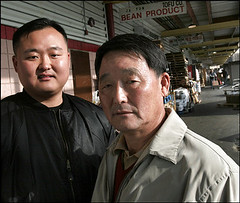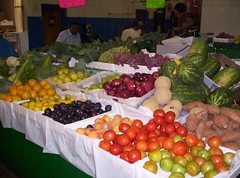AARGH on the Florida Market area
 Sang Oh Choi, right, with his son Jae, is heading a proposal to add housing and retail to the Capital City Market but still preserve space for vendors. (Photo by Nikki Kahn -- The Washington Post).
Sang Oh Choi, right, with his son Jae, is heading a proposal to add housing and retail to the Capital City Market but still preserve space for vendors. (Photo by Nikki Kahn -- The Washington Post). (Contributors of $2,000 to the campaign of Vincent Orange include: Sang Oh & Co, Inc. of Washington, D.C.; Sang O. Choi of Washington, D.C.; Chung Jae Choi of Washington, D.C. from "THE EARLY LINE: Financial reports reveal who's backing whomas 2006 election campaigns get underway," from the Common Denominator.)
The Post has an article today about a redevelopment proposal for the Florida Market area, "Developer Peddles a New Vision for an Old Market."
The problem is that the article doesn't call the"new vision" what it really is: a redevelopment proposal.
Redevelopment equals urban renewal.
Urban renewal means tear everything down. And build new.
Plus, these days, most new design is butt ugly (and the architect of the proposal is the same architect that produced the butt ugly design for condominiums for Square 749).
 Rendering, 200 K Street NE, Washington, DC, Square 749.
Rendering, 200 K Street NE, Washington, DC, Square 749.I apologize that I don't have an image of the New Towns proposal.
The Post article does us all a dis-service by not including that image.
While the Market area might not be the prettiest, it has a charm and beauty that can be revivified, just like Market districts in other cities like Detroit (Eastern Market), San Francisco (Ferry Building), Pittsburgh (Strip District), and Philadelphia (both the Reading Terminal Market and the Italian Market). Links to these entities are present in the "Food-Agriculture" set of links in the right sidebar.
 Me at Young's Deli on the 300 block of Morse Street NE. From a Flickr set of photos on the Wholesale Market District by Elise Bernard.
Me at Young's Deli on the 300 block of Morse Street NE. From a Flickr set of photos on the Wholesale Market District by Elise Bernard.In fact, that is the proposal in the soon to be released "Northeast Gateway Revitalization Plan," developed during a planning process initiated by the DC Office of Planning and written about in the Post exactly one year ago today, "City Study Urges Revitalization in Northeast Areas." And they ran this article one week later, "Despite Challenges and Change, Market Is Still 'Another World': Faced With Ebbing Crowds, Capital City Complex Takes on International Flavor."
These articles share the same author of today's piece but it's as if the other articles were never written.
Revitalization is an asset-based strategy.
Urban renewal is anti-asset and is unsustainable. If urban renewal was such a great strategy, why does Southwest DC lack significant retail and other amenities, and is engaged in a new generation of urban renewal at the "Waterfront" subway station and other areas?
The answer is because it was poorly conceived and costly. New construction for the sake of new construction is great for bankers, lawyers, and other paper pushers, but it is more costly and keeps less money within the community.
Rehabilitation spends less money on materials and more on labor, which should keep more money in the local community (unless people are imported from other places to work, which is an issue in DC).
Frozen Tropics also writes about today's Post article, stating:
I've mentioned this plan before, and frankly, it really concerns me. This guy wants to totally change the character of the area. He hopes to put in an ampitheater & bowling alley (can you say Gallery Place-"Chinatown"?). I think the market is a great neighborhood asset that needs to be redeveloped sensitively. When I look at the Florida Market area, I see the potential for something far greater than Eastern Market (the Florida Ave Market has a lot more area). We're talking about an actual market district that has managed to survive while so many of DC's markets were bulldozed to make way for the future. Lots of cities have wisely embraced & capitalized on districts much like this one.
 I also have a set of photos of the market area too, although some are scrounged from Elise.
I also have a set of photos of the market area too, although some are scrounged from Elise.Index Keywords: urban-revitalization



0 Comments:
Post a Comment
<< Home